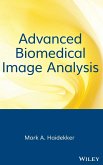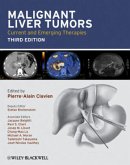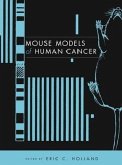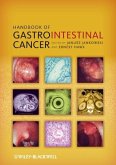Quantitative Imaging Tools for Lung Cancer Drug Assessment
Herausgegeben:Mulshine, James L.; Baer, Thomas M.
Quantitative Imaging Tools for Lung Cancer Drug Assessment
Herausgegeben:Mulshine, James L.; Baer, Thomas M.
- Gebundenes Buch
- Merkliste
- Auf die Merkliste
- Bewerten Bewerten
- Teilen
- Produkt teilen
- Produkterinnerung
- Produkterinnerung
Presents chapters written by leading clinical researchers in the field of lung cancer, where high resolution 3 D imaging technology appears to hold the greatest near term promise, as well as contributions from recognized experts in CAD, medical information technology systems, regulatory procedure, x ray standards development, and clinical trial design. These expert contributors discuss the current state of the art and provide a road map for directing further research in lung cancer as well as other organ systems.
Andere Kunden interessierten sich auch für
![The Cancer Clock The Cancer Clock]() Sotiris Missailidis (ed.)The Cancer Clock72,99 €
Sotiris Missailidis (ed.)The Cancer Clock72,99 €![Biomedical Image w/WS Biomedical Image w/WS]() Mark HaidekkerBiomedical Image w/WS169,99 €
Mark HaidekkerBiomedical Image w/WS169,99 €![Cancer Biomarkers Cancer Biomarkers]() Mahmoud H. HamdanCancer Biomarkers156,99 €
Mahmoud H. HamdanCancer Biomarkers156,99 €![Malignant Liver Tumors Malignant Liver Tumors]() Pierre-Alain Clavien / Stefan Breitenstein / Jacques et al. Belghiti (Hrsg.)Malignant Liver Tumors315,99 €
Pierre-Alain Clavien / Stefan Breitenstein / Jacques et al. Belghiti (Hrsg.)Malignant Liver Tumors315,99 €![Mouse Models of Human Cancer Mouse Models of Human Cancer]() Mouse Models of Human Cancer341,99 €
Mouse Models of Human Cancer341,99 €![Cancer Vaccines and Tumor Immunity Cancer Vaccines and Tumor Immunity]() Rimas OrentasCancer Vaccines and Tumor Immunity170,99 €
Rimas OrentasCancer Vaccines and Tumor Immunity170,99 €![Handbook of Gastrointestinal Cancer Handbook of Gastrointestinal Cancer]() Handbook of Gastrointestinal Cancer75,99 €
Handbook of Gastrointestinal Cancer75,99 €-
-
-
Presents chapters written by leading clinical researchers in the field of lung cancer, where high resolution 3 D imaging technology appears to hold the greatest near term promise, as well as contributions from recognized experts in CAD, medical information technology systems, regulatory procedure, x ray standards development, and clinical trial design. These expert contributors discuss the current state of the art and provide a road map for directing further research in lung cancer as well as other organ systems.
Produktdetails
- Produktdetails
- Verlag: Wiley & Sons
- 1. Auflage
- Seitenzahl: 176
- Erscheinungstermin: 1. April 2008
- Englisch
- Abmessung: 233mm x 164mm x 17mm
- Gewicht: 430g
- ISBN-13: 9780470118801
- ISBN-10: 0470118806
- Artikelnr.: 23495827
- Herstellerkennzeichnung
- Libri GmbH
- Europaallee 1
- 36244 Bad Hersfeld
- gpsr@libri.de
- Verlag: Wiley & Sons
- 1. Auflage
- Seitenzahl: 176
- Erscheinungstermin: 1. April 2008
- Englisch
- Abmessung: 233mm x 164mm x 17mm
- Gewicht: 430g
- ISBN-13: 9780470118801
- ISBN-10: 0470118806
- Artikelnr.: 23495827
- Herstellerkennzeichnung
- Libri GmbH
- Europaallee 1
- 36244 Bad Hersfeld
- gpsr@libri.de
James L. Mulshine, MD, is a Professor of Internal Medicine, Associate Provost of Research and Vice President, Rush University Medical Center in Chicago, Illinois.?In this position, Dr. Mulshine is the primary academic officer responsible for managing research activities at Rush University Medical School. He is an internationally recognized expert on lung cancer.?Over the last few years, Dr. Mulshine has been working with a range of organizations to accelerate the use of high resolution spiral CT in the quantitative evaluation of drug response for early lung cancer.
Preface (Thomas M. Baer and James L. Mulshine).
Chapter 1: Incorporating Imaging into Drug Development: An Industry
Perspective (Philip S. Murphy and Debasish Roychowdhury).
Chapter 2: Developing Imaging Tools for Drug Development: Critical
Technology, Clinical Data and Regulatory (Rafal Dziadziuszko, Fred R.
Hirsch and Paul A. Bunn, Jr).
Chapter 3: Quantitative Imaging in CT Lung Cancer Drug Development and
Evaluation (Ricardo S. Avila).
Chapter 4: Volumetric CT Imaging for Response Assessment in Lung Cancer: A
Platform for Translational Research (Binsheng Zhao and Lawrence H.
Scwhartz).
Chapter 5: Emerging Radiological Software Standards and Development
Technologies: Impact on Clinical Translation and Trials (John Pearson,
Lawrence Tarbox, Gianluca Paladini, John G. Wolodzko, Paula M. Jacobs, and
Zhenghong Lee).
Chapter 6: Statistical Considerations Underlying Therapeutic Response
Criteria for Lung Cancer: A Review in the Context of Emergence of
Multi-Slice CT Scanner and Computer Assisted Diagnostic Algorithm for
Volumetric Assessment (Madhu Mazumdar and Xi Kathy Zhou).
Chapter 7: Programs Supporting Quantitative Imaging in Biomedicine at the
National Institute for Standards and Technology (Thomas M. Baer and Charles
W. Clark).
Appendix A: Evolving Imaging Resources: Public Access Databases (Laurence
Clarke).
Appendix B: Biomedical Imaging Archive Network (Thomas M. Baer and James L.
Mulshine).
Appendix C: Developing CT Image-Processing Tools to Accelerate Progress in
Lung Cancer Drug Development (James L. Mulshine, Ricardo S. Avila, Fred R.
Hirsch, and David Yankelevitz).
Chapter 1: Incorporating Imaging into Drug Development: An Industry
Perspective (Philip S. Murphy and Debasish Roychowdhury).
Chapter 2: Developing Imaging Tools for Drug Development: Critical
Technology, Clinical Data and Regulatory (Rafal Dziadziuszko, Fred R.
Hirsch and Paul A. Bunn, Jr).
Chapter 3: Quantitative Imaging in CT Lung Cancer Drug Development and
Evaluation (Ricardo S. Avila).
Chapter 4: Volumetric CT Imaging for Response Assessment in Lung Cancer: A
Platform for Translational Research (Binsheng Zhao and Lawrence H.
Scwhartz).
Chapter 5: Emerging Radiological Software Standards and Development
Technologies: Impact on Clinical Translation and Trials (John Pearson,
Lawrence Tarbox, Gianluca Paladini, John G. Wolodzko, Paula M. Jacobs, and
Zhenghong Lee).
Chapter 6: Statistical Considerations Underlying Therapeutic Response
Criteria for Lung Cancer: A Review in the Context of Emergence of
Multi-Slice CT Scanner and Computer Assisted Diagnostic Algorithm for
Volumetric Assessment (Madhu Mazumdar and Xi Kathy Zhou).
Chapter 7: Programs Supporting Quantitative Imaging in Biomedicine at the
National Institute for Standards and Technology (Thomas M. Baer and Charles
W. Clark).
Appendix A: Evolving Imaging Resources: Public Access Databases (Laurence
Clarke).
Appendix B: Biomedical Imaging Archive Network (Thomas M. Baer and James L.
Mulshine).
Appendix C: Developing CT Image-Processing Tools to Accelerate Progress in
Lung Cancer Drug Development (James L. Mulshine, Ricardo S. Avila, Fred R.
Hirsch, and David Yankelevitz).
Preface (Thomas M. Baer and James L. Mulshine).
Chapter 1: Incorporating Imaging into Drug Development: An Industry
Perspective (Philip S. Murphy and Debasish Roychowdhury).
Chapter 2: Developing Imaging Tools for Drug Development: Critical
Technology, Clinical Data and Regulatory (Rafal Dziadziuszko, Fred R.
Hirsch and Paul A. Bunn, Jr).
Chapter 3: Quantitative Imaging in CT Lung Cancer Drug Development and
Evaluation (Ricardo S. Avila).
Chapter 4: Volumetric CT Imaging for Response Assessment in Lung Cancer: A
Platform for Translational Research (Binsheng Zhao and Lawrence H.
Scwhartz).
Chapter 5: Emerging Radiological Software Standards and Development
Technologies: Impact on Clinical Translation and Trials (John Pearson,
Lawrence Tarbox, Gianluca Paladini, John G. Wolodzko, Paula M. Jacobs, and
Zhenghong Lee).
Chapter 6: Statistical Considerations Underlying Therapeutic Response
Criteria for Lung Cancer: A Review in the Context of Emergence of
Multi-Slice CT Scanner and Computer Assisted Diagnostic Algorithm for
Volumetric Assessment (Madhu Mazumdar and Xi Kathy Zhou).
Chapter 7: Programs Supporting Quantitative Imaging in Biomedicine at the
National Institute for Standards and Technology (Thomas M. Baer and Charles
W. Clark).
Appendix A: Evolving Imaging Resources: Public Access Databases (Laurence
Clarke).
Appendix B: Biomedical Imaging Archive Network (Thomas M. Baer and James L.
Mulshine).
Appendix C: Developing CT Image-Processing Tools to Accelerate Progress in
Lung Cancer Drug Development (James L. Mulshine, Ricardo S. Avila, Fred R.
Hirsch, and David Yankelevitz).
Chapter 1: Incorporating Imaging into Drug Development: An Industry
Perspective (Philip S. Murphy and Debasish Roychowdhury).
Chapter 2: Developing Imaging Tools for Drug Development: Critical
Technology, Clinical Data and Regulatory (Rafal Dziadziuszko, Fred R.
Hirsch and Paul A. Bunn, Jr).
Chapter 3: Quantitative Imaging in CT Lung Cancer Drug Development and
Evaluation (Ricardo S. Avila).
Chapter 4: Volumetric CT Imaging for Response Assessment in Lung Cancer: A
Platform for Translational Research (Binsheng Zhao and Lawrence H.
Scwhartz).
Chapter 5: Emerging Radiological Software Standards and Development
Technologies: Impact on Clinical Translation and Trials (John Pearson,
Lawrence Tarbox, Gianluca Paladini, John G. Wolodzko, Paula M. Jacobs, and
Zhenghong Lee).
Chapter 6: Statistical Considerations Underlying Therapeutic Response
Criteria for Lung Cancer: A Review in the Context of Emergence of
Multi-Slice CT Scanner and Computer Assisted Diagnostic Algorithm for
Volumetric Assessment (Madhu Mazumdar and Xi Kathy Zhou).
Chapter 7: Programs Supporting Quantitative Imaging in Biomedicine at the
National Institute for Standards and Technology (Thomas M. Baer and Charles
W. Clark).
Appendix A: Evolving Imaging Resources: Public Access Databases (Laurence
Clarke).
Appendix B: Biomedical Imaging Archive Network (Thomas M. Baer and James L.
Mulshine).
Appendix C: Developing CT Image-Processing Tools to Accelerate Progress in
Lung Cancer Drug Development (James L. Mulshine, Ricardo S. Avila, Fred R.
Hirsch, and David Yankelevitz).








